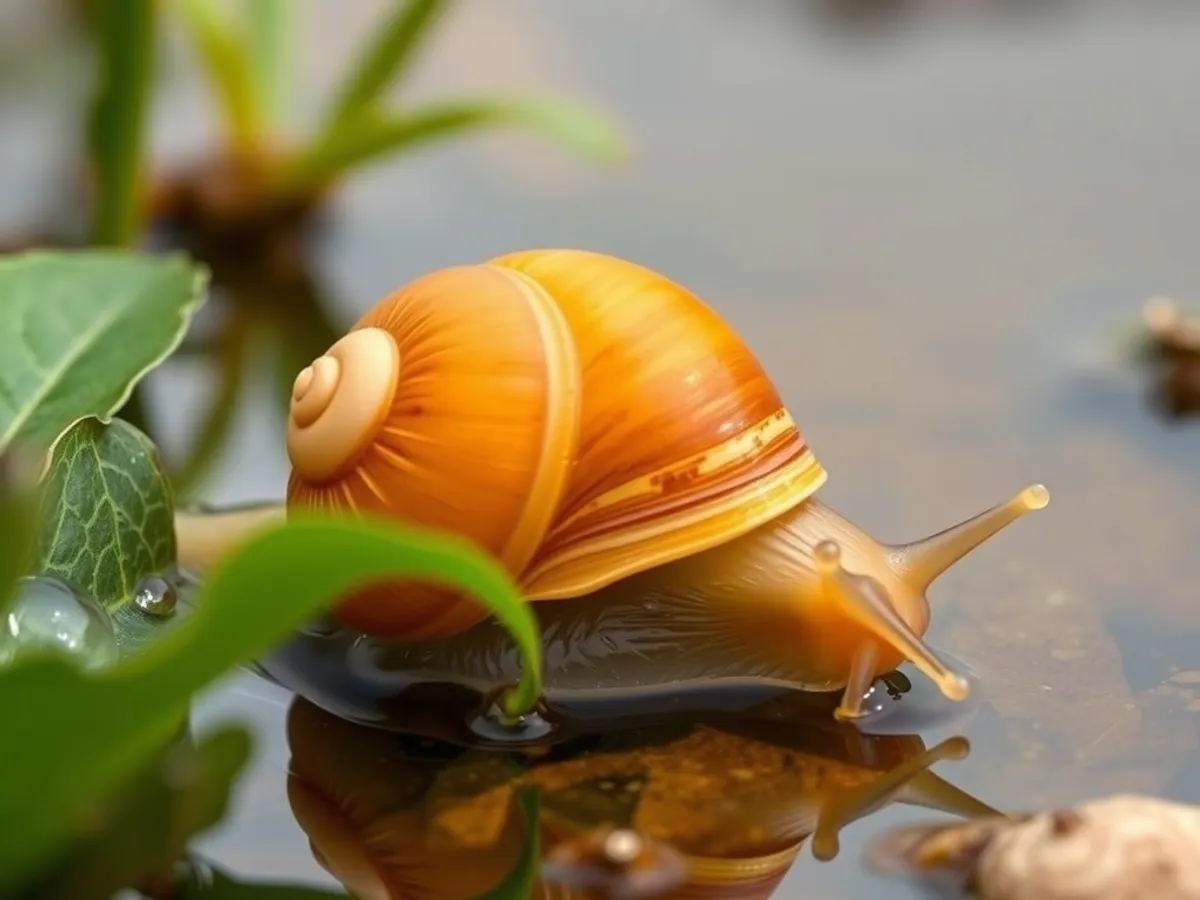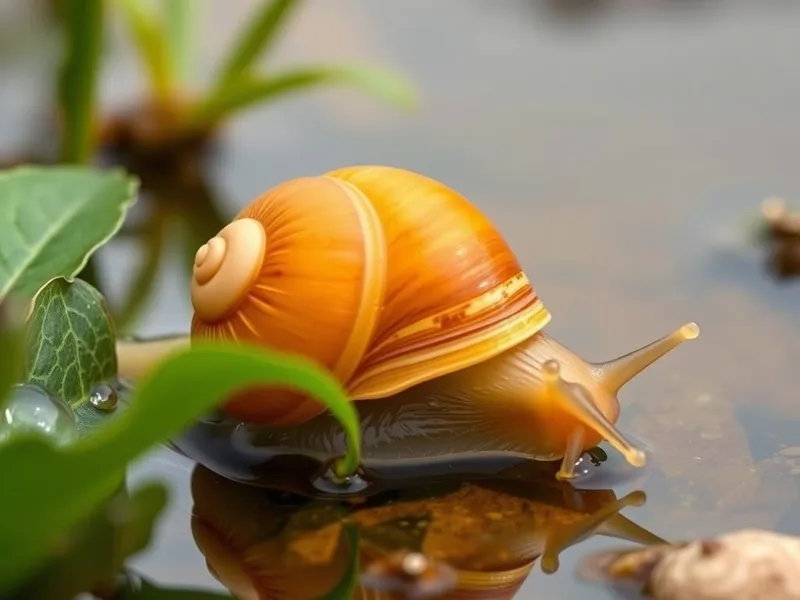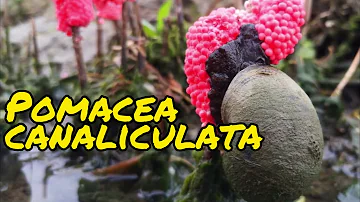
Golden Apple Snail
Pomacea canaliculata

Meet the Golden Apple Snail
The Golden Apple Snail is a large freshwater gastropod native to South America but has become an invasive species in many parts of Asia and other regions. Recognized by its rounded, golden-yellow shell, this snail thrives in rice paddies, wetlands, and slow-moving freshwater bodies. Its voracious appetite for aquatic plants makes it a significant pest in agriculture, particularly in rice cultivation. Despite its pest status, it plays a role in nutrient cycling within its ecosystem and is sometimes kept as an aquarium pet.
Classification
Invertebrate
Habitat
Freshwater wetlands, rice paddies, ponds, and slow-moving rivers
Diet
Herbivore
Lifespan
2-4 years
Conservation
Least Concern
Weight
30-60 grams
📖Fascinating Facts
Bright Pink Eggs
Female Golden Apple Snails lay distinctive, bright pink egg clusters above the water surface to protect them from aquatic predators.
Rice Field Pest
This species is notorious for its impact on rice agriculture, causing extensive crop damage in many Asian countries where it is invasive.
Dual Respiratory System
Golden Apple Snails possess both gills and a lung, allowing them to breathe underwater as well as directly from the air.
📋Detailed Description
The Golden Apple Snail (Pomacea canaliculata) is a large, globular freshwater gastropod, with adult shell diameters typically ranging from 5 to 8 cm, though some individuals may exceed 10 cm. The shell is usually yellow to golden-brown, often with darker spiral bands, and is composed of 5–6 whorls with a deep, channeled suture, giving the species its 'channeled' common name. The body is soft and muscular, with a prominent foot and a siphon used for breathing air at the water's surface. This snail possesses both gills and a lung, allowing it to survive in oxygen-poor or fluctuating aquatic environments. Its eyes are located on stalks, providing a wide field of vision to detect predators. Pomacea canaliculata is primarily nocturnal, spending daylight hours buried in mud or under vegetation. It is a generalist herbivore, feeding on a wide variety of aquatic plants, algae, and detritus, and is capable of consuming significant amounts of biomass, which has major ecological and agricultural impacts. The species is highly adaptable, tolerating a broad range of water conditions, including low oxygen, variable pH, and temporary desiccation by sealing itself within its shell. Its reproductive strategy is prolific, with females laying bright pink egg clutches above the waterline on emergent vegetation or structures, a unique adaptation among freshwater snails. This species is native to the wetlands of South America but has become a notorious invasive pest in Asia, North America, and Europe, where it threatens native biodiversity and agricultural productivity.
💡 Did you know?
Golden Apple Snails can close their shells with a tough operculum, allowing them to survive out of water for several weeks.
🔬Research & Sources
Wikipedia Summary
Pomacea canaliculata, commonly known as the golden apple snail or the channeled apple snail, is a species of large freshwater snail with gills and an operculum, an aquatic gastropod mollusc in the family Ampullariidae, the apple snails. South American in origin, this species is considered to be in the top 100 of the "World's Worst Invasive Alien Species". It is also ranked as the 40th worst alien species in Europe and the worst alien species of gastropod in Europe.
Last Modified: 5/28/2025
🎭Behavior & Social Structure
Pomacea canaliculata exhibits crepuscular and nocturnal activity, foraging primarily at night to avoid diurnal predators. It is a slow-moving grazer, using its radula to rasp soft plant tissues, stems, and leaves, but will also consume detritus and occasionally carrion. The snail is generally solitary, though high population densities can occur in favorable habitats, leading to mass outbreaks. When threatened, it retracts into its shell and seals the aperture with its operculum. During dry or unfavorable conditions, it can enter a state of estivation, burrowing into the substrate and reducing metabolic activity. The species is capable of climbing vertical surfaces, including rice stalks and concrete embankments, to lay eggs or escape rising water. Social interactions are limited, primarily occurring during mating aggregations or in dense feeding areas.
👶Reproduction & Life Cycle
Golden Apple Snails are dioecious, with distinct male and female individuals. Mating can occur year-round in tropical climates but often peaks during the rainy season, when water levels and food availability are optimal. Copulation is prolonged, sometimes lasting several hours, and females can store sperm for multiple clutches. After mating, females ascend above the waterline to deposit conspicuous clusters of 200–600 bright pink eggs on vegetation, rocks, or artificial structures. The eggs are calcified, providing protection from desiccation and many predators. Incubation lasts 10–15 days, depending on temperature and humidity. Upon hatching, juveniles drop into the water and begin feeding immediately. There is no parental care after egg-laying. Sexual maturity is reached in 2–6 months, depending on environmental conditions, and females can produce multiple clutches per season, contributing to rapid population growth.
🛡️Adaptations & Survival
Pomacea canaliculata displays several adaptations for survival in variable freshwater environments. Its dual respiratory system—gills for aquatic respiration and a lung for aerial breathing—enables it to thrive in oxygen-poor or stagnant waters. The operculum allows the snail to seal itself within its shell, preventing desiccation during droughts or exposure to air. Its eggs are laid above the waterline, reducing predation by aquatic organisms and increasing dispersal potential. The bright pink coloration of eggs may deter some predators due to aposematic signaling. The snail's tolerance for a wide range of temperatures (10–36°C), pH, and salinity, as well as its ability to estivate, makes it highly resilient to environmental fluctuations. Its generalist diet and rapid reproductive rate further enhance its invasiveness.
🎨Cultural Significance
In some regions, Pomacea canaliculata has been introduced intentionally as a potential food source, and it is consumed in parts of Southeast Asia after thorough cooking. However, it is also a vector for the rat lungworm parasite (Angiostrongylus cantonensis), posing a public health risk if eaten raw or undercooked. The snail is sometimes kept as an ornamental pet in aquaria due to its attractive shell, but releases from captivity have contributed to its invasive status. In agricultural folklore, the snail is often cited as a symbol of pestilence and crop loss, and its bright pink egg masses are a familiar sight in infested rice paddies.
🔬Recent Research & Discoveries
Recent research has focused on the ecological impacts of Pomacea canaliculata in invaded habitats, including its role in altering nutrient cycling, reducing native plant and snail diversity, and facilitating the spread of plant pathogens. Studies have also examined its physiological tolerance to pollutants and environmental stressors, making it a model organism for ecotoxicology. Genetic analyses have revealed significant population structure and rapid adaptation in introduced ranges. Ongoing research is investigating integrated pest management strategies, including the use of natural predators (e.g., ducks, fish), habitat modification, and targeted molluscicides. The species is also of interest in parasitology due to its role as an intermediate host for zoonotic nematodes.
🎥Wildlife Videos

Giant Snail Uses "Snorkel" to Breathe Underwater | How Nature Works | BBC Earth
Floods are slowly suffocating the Pantanal's ecosystem, but luckily, these ingenious water-breathing snails might be able to save ...
BBC Earth

Golden Apple Snail(Scientific name: Pomacea canaliculata): The Ecological Killer You Don't Know
Golden Apple Snail, native to South America, was introduced to Asia as an edible snail. They look harmless and even a little ...
Ruijinte Inc

'Apple snails' invading Katy neighborhood
An invasive and aggressive species of snail has popped up in the Tamarron community in Katy.
KHOU 11

Invasive Apple Snail Life Cycle
The invasive apple snail (Pomacea canaliculate) is widely considered one of the most invasive invertebrates of waterways and ...
CABI PlantwisePlus

Golden apple snails lay lovely pink eggs 😍 | Tropical Forest Bees
Golden apple snails lay lovely pink eggs | Tropical Forest Bees A female snail is laying lovely, adorable eggs. and the small, ...
Tropical Forest Bees

golden apple snails Pomacea canaliculata
The eggs of Pomacea canaliculata. The snail is consumed in China and Southeast Asia.
Pixiest
🌍Habitat Information
The Golden Apple Snail typically inhabits Freshwater wetlands, rice paddies, ponds, and slow-moving rivers environments. Golden Apple Snails have adapted to their environments with specialized features and behaviors.
Primary Habitat:
Freshwater wetlands, rice paddies, ponds, and slow-moving rivers
More detailed habitat information will be available soon.
🛡️Conservation Status
The Golden Apple Snail is currently classified as Least Concern. Conservation efforts are crucial for preserving this species for future generations.
Common Threats:
- 🏠Habitat loss and fragmentation
- 🌡️Climate change impacts
- 🎯Hunting and poaching
- 🏭Human-wildlife conflict
⚠️Threats & Conservation Challenges
In its native range, Pomacea canaliculata faces predation from birds, mammals, and reptiles, as well as parasitism by trematodes. However, in introduced regions, its populations often lack natural predators, leading to explosive growth. Major threats to the species are minimal due to its adaptability and reproductive capacity, and it is listed as Least Concern by the IUCN. However, the species poses significant challenges as an invasive pest, causing extensive damage to rice and taro crops, outcompeting native snails, and altering wetland ecosystems. Control efforts include manual removal, chemical molluscicides, and biological control, but these measures can have unintended ecological impacts. Human-mediated dispersal, such as through the aquarium trade and contaminated agricultural equipment, continues to facilitate its spread.
🔬Scientific Classification
Scientific Name
Pomacea canaliculata
Classification Hierarchy
🔍 About Taxonomic Classification
Taxonomic classification is a hierarchical system used by scientists to classify and organize living organisms based on shared characteristics and evolutionary relationships.
The system moves from broad categories (Kingdom) to increasingly specific ones, with each animal's scientific name typically consisting of its Genus and species.
📝Community Notes
Share your observations and insights about the Golden Apple Snail with our community of wildlife enthusiasts.
Join Our Community
Sign in to share your observations and connect with fellow wildlife enthusiasts.
Sign In to ContributeNo community notes yet
Be the first to share your observations about the Golden Apple Snail!
Explore Golden Apple Snail
Select a tab above to learn more about this amazing animal.
📸Photo Gallery
No photos available for this animal yet.
🌟Discover More Wildlife
Continue your journey of discovery with more fascinating animals from our database
